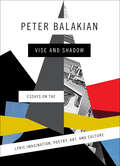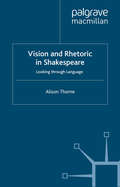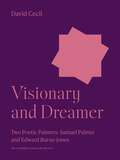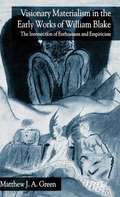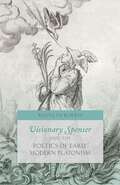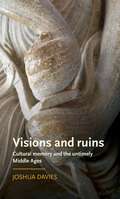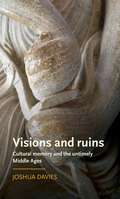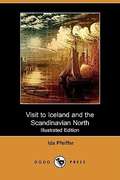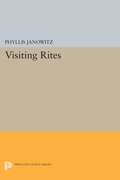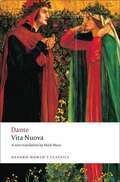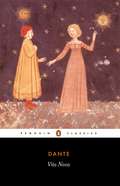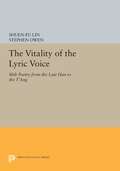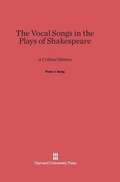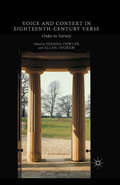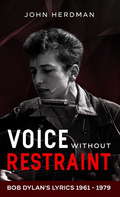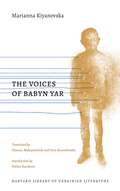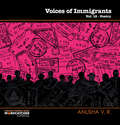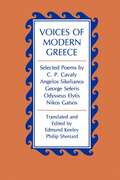- Table View
- List View
Vise and Shadow: Essays on the Lyric Imagination, Poetry, Art, and Culture
by Peter BalakianPeter Balakian is a renowned poet, scholar, and memoirist; but his work as an essayist often prefigures and illuminates all three. "I think of vise and shadow as two dimensions of the lyric (literary and visual) imagination," he writes in the preface to this collection, which brings together essayistic writings produced over the course of twenty-five years. Vise, "as in grabbing and holding with pressure," but also in the sense of the vise-grip of the imagination, which can yield both clarity and knowledge. Consider the vise-grip of some of the poems of our best lyric poets, how language might be put under pressure "as carbon might be put under pressure to create a diamond." And shadow, the second half of the title: both as noun, "the shaded or darker portion of the picture or view or perspective," "partial illumination and partial darkness"; and as verb, to shadow, "to trail secretly as an inseparable companion" or a "force that follows something with fidelity; to cast a dark light on something—a person, an event, an object, a form in nature." Vise and Shadow draws into conversation such disparate figures as W. B. Yeats, Hart Crane, Joan Didion, Primo Levi, Robert Rauschenberg, Bob Dylan, Elia Kazan, and Arshile Gorky, revealing how the lyric imagination of these artists grips experience, "shadows history," and "casts its own type of illumination," creating one of the deepest kinds of human knowledge and sober truth. In these elegantly written essays, Balakian offers a fresh way to think about the power of poetry, art, and the lyrical imagination as well as history, trauma, and memory.
Vise and Shadow: Essays on the Lyric Imagination, Poetry, Art, and Culture
by Peter BalakianPeter Balakian is a renowned poet, scholar, and memoirist; but his work as an essayist often prefigures and illuminates all three. "I think of vise and shadow as two dimensions of the lyric (literary and visual) imagination," he writes in the preface to this collection, which brings together essayistic writings produced over the course of twenty-five years. Vise, "as in grabbing and holding with pressure," but also in the sense of the vise-grip of the imagination, which can yield both clarity and knowledge. Consider the vise-grip of some of the poems of our best lyric poets, how language might be put under pressure "as carbon might be put under pressure to create a diamond." And shadow, the second half of the title: both as noun, "the shaded or darker portion of the picture or view or perspective," "partial illumination and partial darkness"; and as verb, to shadow, "to trail secretly as an inseparable companion" or a "force that follows something with fidelity; to cast a dark light on something—a person, an event, an object, a form in nature." Vise and Shadow draws into conversation such disparate figures as W. B. Yeats, Hart Crane, Joan Didion, Primo Levi, Robert Rauschenberg, Bob Dylan, Elia Kazan, and Arshile Gorky, revealing how the lyric imagination of these artists grips experience, "shadows history," and "casts its own type of illumination," creating one of the deepest kinds of human knowledge and sober truth. In these elegantly written essays, Balakian offers a fresh way to think about the power of poetry, art, and the lyrical imagination as well as history, trauma, and memory.
Vise and Shadow: Essays on the Lyric Imagination, Poetry, Art, and Culture
by Peter BalakianPeter Balakian is a renowned poet, scholar, and memoirist; but his work as an essayist often prefigures and illuminates all three. "I think of vise and shadow as two dimensions of the lyric (literary and visual) imagination," he writes in the preface to this collection, which brings together essayistic writings produced over the course of twenty-five years. Vise, "as in grabbing and holding with pressure," but also in the sense of the vise-grip of the imagination, which can yield both clarity and knowledge. Consider the vise-grip of some of the poems of our best lyric poets, how language might be put under pressure "as carbon might be put under pressure to create a diamond." And shadow, the second half of the title: both as noun, "the shaded or darker portion of the picture or view or perspective," "partial illumination and partial darkness"; and as verb, to shadow, "to trail secretly as an inseparable companion" or a "force that follows something with fidelity; to cast a dark light on something—a person, an event, an object, a form in nature." Vise and Shadow draws into conversation such disparate figures as W. B. Yeats, Hart Crane, Joan Didion, Primo Levi, Robert Rauschenberg, Bob Dylan, Elia Kazan, and Arshile Gorky, revealing how the lyric imagination of these artists grips experience, "shadows history," and "casts its own type of illumination," creating one of the deepest kinds of human knowledge and sober truth. In these elegantly written essays, Balakian offers a fresh way to think about the power of poetry, art, and the lyrical imagination as well as history, trauma, and memory.
Vise and Shadow: Essays on the Lyric Imagination, Poetry, Art, and Culture
by Peter BalakianPeter Balakian is a renowned poet, scholar, and memoirist; but his work as an essayist often prefigures and illuminates all three. "I think of vise and shadow as two dimensions of the lyric (literary and visual) imagination," he writes in the preface to this collection, which brings together essayistic writings produced over the course of twenty-five years. Vise, "as in grabbing and holding with pressure," but also in the sense of the vise-grip of the imagination, which can yield both clarity and knowledge. Consider the vise-grip of some of the poems of our best lyric poets, how language might be put under pressure "as carbon might be put under pressure to create a diamond." And shadow, the second half of the title: both as noun, "the shaded or darker portion of the picture or view or perspective," "partial illumination and partial darkness"; and as verb, to shadow, "to trail secretly as an inseparable companion" or a "force that follows something with fidelity; to cast a dark light on something—a person, an event, an object, a form in nature." Vise and Shadow draws into conversation such disparate figures as W. B. Yeats, Hart Crane, Joan Didion, Primo Levi, Robert Rauschenberg, Bob Dylan, Elia Kazan, and Arshile Gorky, revealing how the lyric imagination of these artists grips experience, "shadows history," and "casts its own type of illumination," creating one of the deepest kinds of human knowledge and sober truth. In these elegantly written essays, Balakian offers a fresh way to think about the power of poetry, art, and the lyrical imagination as well as history, trauma, and memory.
Vise and Shadow: Essays on the Lyric Imagination, Poetry, Art, and Culture
by Peter BalakianPeter Balakian is a renowned poet, scholar, and memoirist; but his work as an essayist often prefigures and illuminates all three. "I think of vise and shadow as two dimensions of the lyric (literary and visual) imagination," he writes in the preface to this collection, which brings together essayistic writings produced over the course of twenty-five years. Vise, "as in grabbing and holding with pressure," but also in the sense of the vise-grip of the imagination, which can yield both clarity and knowledge. Consider the vise-grip of some of the poems of our best lyric poets, how language might be put under pressure "as carbon might be put under pressure to create a diamond." And shadow, the second half of the title: both as noun, "the shaded or darker portion of the picture or view or perspective," "partial illumination and partial darkness"; and as verb, to shadow, "to trail secretly as an inseparable companion" or a "force that follows something with fidelity; to cast a dark light on something—a person, an event, an object, a form in nature." Vise and Shadow draws into conversation such disparate figures as W. B. Yeats, Hart Crane, Joan Didion, Primo Levi, Robert Rauschenberg, Bob Dylan, Elia Kazan, and Arshile Gorky, revealing how the lyric imagination of these artists grips experience, "shadows history," and "casts its own type of illumination," creating one of the deepest kinds of human knowledge and sober truth. In these elegantly written essays, Balakian offers a fresh way to think about the power of poetry, art, and the lyrical imagination as well as history, trauma, and memory.
Vision and Rhetoric in Shakespeare: Looking through Language
by A. ThorneThis major new interdisciplinary study argues that Shakespeare exploited long-established connections between vision, space and language in order to construct rhetorical equivalents for visual perspective. Through a detailed comparison of art and poetic theory in Italy and England, Thorne shows how perspective was appropriated by English writers, who reinterpreted it to suit their own literary concerns and cultural context. Focusing on five Shakespearean plays, she situates their preoccupation with issues of viewpoint in relation to a range of artistic forms and topics from miniatures to masques.
Visionary and Dreamer: Two Poetic Painters: Samuel Palmer and Edward Burne-Jones (The A. W. Mellon Lectures in the Fine Arts #15)
by David CecilAn eminent literary biographer and critic shows how poetry enriched the art of two representative English Romantic paintersIn Visionary and Dreamer, David Cecil evokes the century of the poet-painter, when painting drew much of its inspiration from imaginative literature. Samuel Palmer (1805–1881), an unworldly visionary, obscure in his lifetime but now a recognized master, and Edward Burne-Jones (1833–1898), the Pre-Raphaelite daydreamer, once revered as a great painter but later admired chiefly for his work in applied art, emerge as artists who turned to their own inner lives to interpret Shakespeare, Milton, and Keats.
Visionary Materialism in the Early Works of William Blake: The Intersection of Enthusiasm and Empiricism
by M. GreenIncorporating the most recent discoveries concerning Blake's heritage and cultural context, Visionary Materialism in the Early Works of William Blake: The Intersection of Enthusiasm and Empiricism proposes a radical new reading of his early works, that sees them taking enlightenment ideas to heights never dreamed of by Locke and Priestley. Drawing on a careful analysis of key figures from both sides of the enlightenment/counter-enlightenment divide (including Boehme, Swedenborg, the Moravians, Lavater, Brothers, Erasmus Darwin), the discussion traces an alternative tradition that disrupts previous assumptions about important aspects of Blake's thought.
Visionary Spenser and the Poetics of Early Modern Platonism
by Kenneth BorrisPlatonic concerns and conceptions profoundly affected early modern English and continental poetics, yet the effects have had little attention. This book defines Platonism's roles in early modern theories of literature, then reappraise the Platonizing major poet Edmund Spenser. It makes important new contributions to the knowledge of early modern European poetics and advances our understanding of Spenser's role and significance in English literary history. Literary Platonism energized pursuits of the sublime, and knowledge of this approach to poetry yields cogent new understandings of Spenser's poetics, his principal texts, his poetic vocation, and his cultural influence. By combining Christian resources with doctrines of Platonic poetics such as the poet's and lover's inspirational furies, the revelatory significance of beauty, and the importance of imitating exalted ideals rather than the world, he sought to attain a visionary sublimity that would ensure his enduring national significance, and he thereby became a seminal figure in the English literary "line of vision" including Milton and Blake among others. Although readings of Spenser's Shepheardes Calender typically bypass Plato's Phaedrus, this text deeply informs the Calender's treatments of beauty, inspiration, poetry's psychagogic power, and its national responsibilities. In The Faerie Queene, both heroism and visionary poetics arise from the stimuli of love and beauty conceived Platonically, and idealized mimesis produces its faeryland. Faery's queen, projected from Elizabeth I as in Platonic idealization of the beloved, not only pertains to temporal governance but also points toward the transcendental Ideas and divinity. Whereas Plato's Republic valorizes philosophy for bringing enlightenment to counter society's illusions, Spenser champions the learned and enraptured poetic imagination, and proceeds as such a philosopher-poet.
Visionary Spenser and the Poetics of Early Modern Platonism
by Kenneth BorrisPlatonic concerns and conceptions profoundly affected early modern English and continental poetics, yet the effects have had little attention. This book defines Platonism's roles in early modern theories of literature, then reappraise the Platonizing major poet Edmund Spenser. It makes important new contributions to the knowledge of early modern European poetics and advances our understanding of Spenser's role and significance in English literary history. Literary Platonism energized pursuits of the sublime, and knowledge of this approach to poetry yields cogent new understandings of Spenser's poetics, his principal texts, his poetic vocation, and his cultural influence. By combining Christian resources with doctrines of Platonic poetics such as the poet's and lover's inspirational furies, the revelatory significance of beauty, and the importance of imitating exalted ideals rather than the world, he sought to attain a visionary sublimity that would ensure his enduring national significance, and he thereby became a seminal figure in the English literary "line of vision" including Milton and Blake among others. Although readings of Spenser's Shepheardes Calender typically bypass Plato's Phaedrus, this text deeply informs the Calender's treatments of beauty, inspiration, poetry's psychagogic power, and its national responsibilities. In The Faerie Queene, both heroism and visionary poetics arise from the stimuli of love and beauty conceived Platonically, and idealized mimesis produces its faeryland. Faery's queen, projected from Elizabeth I as in Platonic idealization of the beloved, not only pertains to temporal governance but also points toward the transcendental Ideas and divinity. Whereas Plato's Republic valorizes philosophy for bringing enlightenment to counter society's illusions, Spenser champions the learned and enraptured poetic imagination, and proceeds as such a philosopher-poet.
Visions and ruins: Cultural memory and the untimely Middle Ages (G - Reference, Information and Interdisciplinary Subjects)
by Joshua DaviesThis study works with texts in Old English, Middle English and Latin, as well as material and visual culture, to explore how representations of the past created in the British Middle Ages have been reimagined in modernity.
Visions and ruins: Cultural memory and the untimely Middle Ages (Manchester Medieval Literature and Culture)
by Joshua DaviesVisions and ruins explores the production of cultural memory in the Middle Ages and the uses the medieval past has been put to in modernity. Working with texts in Old English, Middle English and Latin, as well as visual and material culture, it traces connections in time, place, language and media to explore the temporal complexities of cultural production and subject formation. The book interrogates critical, poetic, artistic and political archives to reveal exchanges of cultural energy and influence between past and present, offering new ways of knowing the medieval past and the contemporary moment.
Visit to Iceland and the Scandinavian North
by Ida PfeifferA besetting sin of the Icelanders is their drunkenness. Their poverty would probably not be so great if they were less devoted to brandy, and worked more industriously. <P> <P> It is dreadful to see what deep root this vice has taken. Not only on Sundays, but also on week-days, I met peasants who were so intoxicated that I was surprised how they could keep in their saddle. I am, however, happy to say that I never saw a woman in this degrading condition.
Visiting Rites
by Phyllis JanowitzThe description for this book, Visiting Rites, will be forthcoming.Originally published in 1982.The Princeton Legacy Library uses the latest print-on-demand technology to again make available previously out-of-print books from the distinguished backlist of Princeton University Press. These editions preserve the original texts of these important books while presenting them in durable paperback and hardcover editions. The goal of the Princeton Legacy Library is to vastly increase access to the rich scholarly heritage found in the thousands of books published by Princeton University Press since its founding in 1905.
Vita Nuova: (pdf) (Oxford World's Classics Ser.)
by Dante Dante Alighieri Mark MusaVita Nuova (1292-94) is the first of Dante's major writings. It is a supreme work of love; thirty-one poems are linked by a lyrical prose narrative poem celebrating and debating the subject of love. In the opening chapter Dante sets himself the task of giving meaning to the poetry which he composed and the events which took place after his meeting with Beatrice and the `Lord of Love'. The `new life' which this meeting inspired is the subject of Dante's most profound creation, which has been read variously as biography, religious allegory, and a meditation on poetry itself. ABOUT THE SERIES: For over 100 years Oxford World's Classics has made available the widest range of literature from around the globe. Each affordable volume reflects Oxford's commitment to scholarship, providing the most accurate text plus a wealth of other valuable features, including expert introductions by leading authorities, helpful notes to clarify the text, up-to-date bibliographies for further study, and much more.
Vita Nuova: (the New Life) Secondo La Lezione Del Cod. Strozziano Vi, 143 - Primary Source Edition (El\libro De Bolsillo Ser.)
by Dante Alighieri Barbara ReynoldsA unique treatise by a poet, written for poets, on the art of poetry, LA VITA NUOVA is elaborately and symbolically patterned, consisting of a selection of Dante's early poems, interspersed with his own prose commentary. The poems themselves tell the story of his love for Beatrice, from their first meeting at a May Day party in her father's house, through Dante's sufferings and his attempts to conceal the true object of his devotion by the use of 'screen-loves', to his overwhelming grief ather death, ending with the transformative vision of her in heaven. These are some of the richest love poems in literature and the movement from self-pitying lament to praise for the beloved's beauty and virtue, illustrate the elevating power of love.
The Vitality of the Lyric Voice: Shih Poetry from the Late Han to the T'ang
by Shuen-Fu Lin Stephen OwenThis volume presents twelve essays on the evolution of shih poetry from the second to the tenth century, the period that began with the sudden flowering of shih poetry in live-character meter and culminated in the T'ang, the golden age of classical Chinese poetry.Originally published in 1987.The Princeton Legacy Library uses the latest print-on-demand technology to again make available previously out-of-print books from the distinguished backlist of Princeton University Press. These editions preserve the original texts of these important books while presenting them in durable paperback and hardcover editions. The goal of the Princeton Legacy Library is to vastly increase access to the rich scholarly heritage found in the thousands of books published by Princeton University Press since its founding in 1905.
The Vocal Songs in the Plays of William Shakespeare: A Critical History (PDF)
by Peter J. SengThe Vocal Songs in the Plays of William Shakespeare: A Critical History
Voice and Context in Eighteenth-Century Verse: Order in Variety
by Allan Ingram Joanna FowlerThis collection of essays reassesses the importance of verse as a medium in the long eighteenth century, and as an invitation for readers to explore many of the less familiar figures dealt with, alongside the received names of the standard criticism of the period.
Voice Without Restraint: Bob Dylan's Lyrics 1961 - 1979
by John HerdmanBob Dylan was awarded the Nobel Prize in Literature in June 2016, and seldom in recent years has it been more richly deserved.That a song writer’s lyrics should be regarded as literature was an idea at which many were surprised.Others have felt that to isolate the lyrics of a song from its musical context is unreal. Ultimately that is true: a song is an indefeasible whole, an inseparable marriage of words and music which achieves its overall emotional effect by that symbiosis and not otherwise.Yet it can also be said that the two components can be separately considered as two elements in the artist’s creative utterance, and discussed as such.The evidence of Dylan’s manuscripts supports the view that in writing his lyrics his way of going about things is not always widely different from that of a poet.Bob Dylan commented on the Nobel Prize in Literature which was awarded to him "for having created new poetic expressions within the great American song tradition": "When I first received this Nobel Prize for Literature, I got to wondering exactly how my songs related to literature. I wanted to reflect on it and see where the connection was."Voice Without Restraint, refers to and is from the song “I dreamed I saw St Augustine” on John Wesley Harding, and is a phrase chosen to evoke the full-blooded commitment to his artistic utterance which is the hallmark of Bob Dylan’s voice – in all senses.
Voices of Angel Island: Inscriptions and Immigrant Poetry, 1910-1945
by Charles EganVoices of Angel Island is a historical and literary anthology of the writings of immigrants detained at Angel Island, designed to provide a conduit for readers today to connect with early-20th-century perspectives on the process of "becoming American." The Angel Island Immigration Station in San Francisco Bay has been called the "Ellis Island of the West," but its purpose was quite different. It was primarily a detention center, established in large part to discourage immigration by Asians. The station barracks contain an extraordinary archive: hundreds of poems and prose records in half a dozen languages are on the walls, inscribed by immigrant detainees between 1910 and 1940, and by POWs and "enemy aliens" during World War II. Charles Egan draws on over a decade's work deciphering the wall inscriptions by Japanese, Chinese, Korean, European, and other detainees to assemble a selection of their writings in this book, alongside literary materials from Bay Area ethnic newspapers. While each inscription tells the story of an individual, taken together they illuminate the historical, economic, and cultural forces that shaped the lives of ordinary people in the early 20th century.
Voices of Angel Island: Inscriptions and Immigrant Poetry, 1910-1945
by Charles EganVoices of Angel Island is a historical and literary anthology of the writings of immigrants detained at Angel Island, designed to provide a conduit for readers today to connect with early-20th-century perspectives on the process of "becoming American." The Angel Island Immigration Station in San Francisco Bay has been called the "Ellis Island of the West," but its purpose was quite different. It was primarily a detention center, established in large part to discourage immigration by Asians. The station barracks contain an extraordinary archive: hundreds of poems and prose records in half a dozen languages are on the walls, inscribed by immigrant detainees between 1910 and 1940, and by POWs and "enemy aliens" during World War II. Charles Egan draws on over a decade's work deciphering the wall inscriptions by Japanese, Chinese, Korean, European, and other detainees to assemble a selection of their writings in this book, alongside literary materials from Bay Area ethnic newspapers. While each inscription tells the story of an individual, taken together they illuminate the historical, economic, and cultural forces that shaped the lives of ordinary people in the early 20th century.
The Voices of Babyn Yar (Harvard library of ukrainian literature; #3)
by Marianna KiyanovskaWith The Voices of Babyn Yar—a collection of stirring poems by Marianna Kiyanovska—the award-winning Ukrainian poet honors the victims of the Holocaust by writing their stories of horror, death, and survival by projecting their own imagined voices. Artful and carefully intoned, the poems convey the experiences of ordinary civilians going through unbearable events leading to the massacre at Kyiv’s Babyn Yar from a first-person perspective to an effect that is simultaneously immersive and estranging. While conceived as a tribute to the fallen, the book raises difficult questions about memory, responsibility, and commemoration of those who had witnessed an evil that verges on the unspeakable.
Voices of Immigrants: Vol. 18 - Poetry (Creative Portfolio Series #18)
by Anusha V. R.In today's world, everyone has an opinion on immigration. But what do the immigrants have to say? These poems reflect the voices of immigrants the poet has heard during her travels across the world.
Voices of Modern Greece: Selected Poems by C.P. Cavafy, Angelos Sikelianos, George Seferis, Odysseus Elytis, Nikos Gatsos
by Edmund Keeley Philip SherrardThis anthology is composed of recently revised translations selected from the five volumes of work by major poets of modern Greece offered by Edmund Keeley and Philip Sherrard during the past two decades. The poems chosen are those that translate most successfully into English and that are also representative of the best work of the original poets. C. P. Cavafy and Angelos Sikelianos are major poets of the first half of the twentieth century. George Seferis and Odysseus Elytis, who followed them, both won the Nobel Prize in literature. Nikos Gatsos is a very popular translator, lyricist, and critic.
